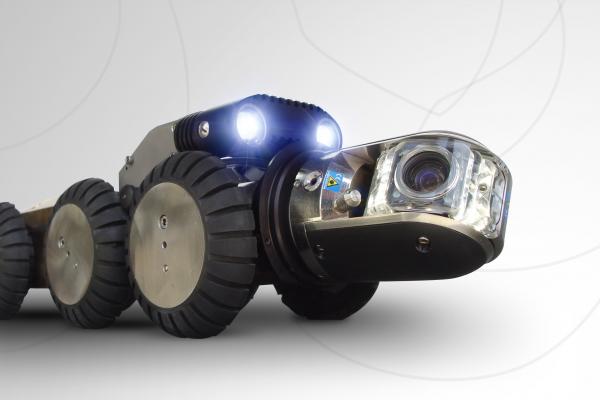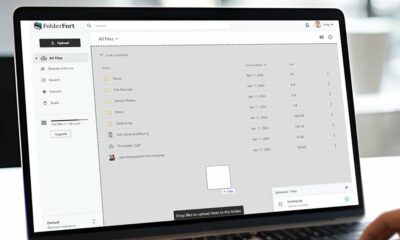TECHNOLOGY
Robots Help Prevent Leaks and Improve Inspection for Pipe Networks

Underground utilities might be out of sight, but they are vital to our everyday lives.
Robotic pipe inspection helps utility providers maintain the underground infrastructure transporting water to millions. How do robots inspect pipes, prevent leaks and improve utility maintenance?
How Robotic Pipe Inspection Works

Robotic pipe inspection is becoming increasingly popular thanks to recent advances in engineering. It’s possible today to build small, nimble, waterproof robots perfect for navigating the unique environment of underground pipes. There are many distinct pipe inspection robots on the market, but most take a similar approach to the task.
Utility inspectors start by bringing the robot to an entry point for the pipe system they want to investigate, such as a maintenance hole. Most pipe inspection robots are tethered and remote-controlled so the inspector can see a live feed from the robot’s camera and direct where it goes. Wheels are the most common form of movement, but some pipe inspection robots also use worm-like designs that help them fit into narrower pipes.
The tether might sound unwieldy, but it serves a few essential functions. This extra-long cable powers the robot, so it doesn’t need a battery pack and can’t die in a pipe. It also transmits data from the robot to an inspector’s aboveground computer. Additionally, the tether allows inspectors to retrieve the robot if something goes wrong.
Cameras and sensors on the robot allow it to collect information about underground utilities, including leak detection. Some robots act mainly as remote-controlled cameras. In this case, the inspector will use the cameras to scan the pipes visually for signs of a leak. If one is spotted, the robot records the location for repairs.
Other pipe inspection robots use sensors to paint a picture of what’s happening inside a pipe. Sensors are crucial for autonomous robotic pipe inspection, where a human is not watching robot footage in real-time. In this case, sensor data and camera footage are used to identify signs of leaks, such as excess moisture, visual pipe damage or debris buildup. Some waterproof robots can even detect water pollution in addition to finding leaky pipes.
Innovating the Underground Utilities Industry

Why use robotic pipe inspection rather than traditional inspection methods? This technology has some amazing benefits, including an easier, safer inspection process.
Less Destructive Inspections and Repairs
One of the most significant benefits of robotic pipe inspection is its non-destructive nature. Inspecting pipes often required digging them up in the past since inspectors had no other way of seeing buried utility infrastructure. Digging is time and resource intensive. It also creates noise and physically disrupts the surrounding environment.
In contrast, robotic pipe inspection is quiet, fast and requires no digging. This reduces the cost of inspections and prevents possible unnecessary damage to pipes. During installation, pipes need layers of insulation to prevent leaks, cracks and damage and provide a vapour barrier. Digging up pipes to inspect them could damage these carefully installed insulation systems.
If inspection robots spot signs of a leak, a repair group can dig up a specific section of pipes without disrupting other areas. This system minimises the digging necessary by concentrating only on sections of pipe confirmed to have leaks or further damage.
Improved Safety
Automating underground utilities inspection improves job safety for utility workers. Annual injury rates are falling in the utility industry due to a combination of factors such as improved safety practises and the integration of new technologies. Robots can make underground pipe inspection safer by reducing the physical work required.
While many pipe systems are too narrow for humans to enter, the physical work required to dig up and manually inspect pipes can lead to injuries. For example, a utility inspector could cut their hand while working with digging equipment. The trenches required for working with buried structures like pipes also increase the risk of injury.
With robots, fewer utility workers are necessary for inspections, instantly reducing the risk of injury. Additionally, very little equipment is required and what is needed is generally harmless. Most robots are controlled with a laptop or tablet, which is in more danger of damage than a utility worker. The robot also goes underground instead of a person, eliminating risks like pipe or trench collapse.
Simplified Inspection Process
The underground utilities inspection process is much faster and easier than conventional inspection methods. Robotic pipe inspection allows one or two people to inspect a whole network of pipes with just a computer and the robot’s required gear. They don’t have to dig or survey the land, so the process of conducting an inspection is simple and straightforward.
Easy underground utilities inspection is important for improving the quality of pipe maintenance. Inspections are performed less frequently when they are expensive and time consuming to conduct. Quick, easy, low-cost inspections allow utility providers to perform more frequent inspections which allows them to catch cracks, leaks and other potential problems sooner.
Early leak detection minimises the negative impact of leaks and results in smaller repairs. It also reduces the risk of a small leak worsening into a much bigger issue. For example, pipe leaks can allow contaminants into pipe networks, creating health and structural risks. Catching leaks early prevents serious side effects from taking root.
The Future of Underground Utilities Robots
Robotic utilities inspection is a relatively new technology that became widely accessible in the last few years. As adoption grows, developers and researchers are hard at work creating more advanced robots. How will the technology change and improve down the road?
Modern underground utilities inspection robots usually require a tether and remote control. In the future, they could be fully autonomous and fully wireless. Some robots may retain a tether for use in a mechanical failure or malfunction.
Fully autonomous pipe inspection robots will allow utility providers to have 24/7 pipe monitoring. Early versions of these robots use AI to operate and communicate with the robots and collect data through cameras and sensors. For example, researchers at the University of Sheffield developed fully autonomous pipe crawler robots that use microphones to listen to the pipes and analyse the sounds for signs of leaks.
Along with fully autonomous inspections, underground utilities robots may one day be able to conduct minor repairs. For example, if an autonomous inspection robot spots an emerging crack, it can patch it before it creates a leak. This technology isn’t available yet, but one day it could be a reality, likely by integrating 3D printing technology into pipe crawler robots.
The Incredible World of Robotic Pipe Inspection
Robotic pipe inspection is a groundbreaking milestone in underground utilities maintenance, although it removes the need for inspectors to break the ground at all! Robots are helping utility providers take better care of pipes and perform maintenance safer, faster and for less money. In the future, pipe crawler robots could become fully autonomous, roaming pipes 24/7 with the help of AI.
TECHNOLOGY
Next-gen chips, Amazon Q, and speedy S3

AWS re:Invent, which has been taking place from November 27 and runs to December 1, has had its usual plethora of announcements: a total of 21 at time of print.
Perhaps not surprisingly, given the huge potential impact of generative AI – ChatGPT officially turns one year old today – a lot of focus has been on the AI side for AWS’ announcements, including a major partnership inked with NVIDIA across infrastructure, software, and services.
Yet there has been plenty more announced at the Las Vegas jamboree besides. Here, CloudTech rounds up the best of the rest:
Next-generation chips
This was the other major AI-focused announcement at re:Invent: the launch of two new chips, AWS Graviton4 and AWS Trainium2, for training and running AI and machine learning (ML) models, among other customer workloads. Graviton4 shapes up against its predecessor with 30% better compute performance, 50% more cores and 75% more memory bandwidth, while Trainium2 delivers up to four times faster training than before and will be able to be deployed in EC2 UltraClusters of up to 100,000 chips.
The EC2 UltraClusters are designed to ‘deliver the highest performance, most energy efficient AI model training infrastructure in the cloud’, as AWS puts it. With it, customers will be able to train large language models in ‘a fraction of the time’, as well as double energy efficiency.
As ever, AWS offers customers who are already utilising these tools. Databricks, Epic and SAP are among the companies cited as using the new AWS-designed chips.
Zero-ETL integrations
AWS announced new Amazon Aurora PostgreSQL, Amazon DynamoDB, and Amazon Relational Database Services (Amazon RDS) for MySQL integrations with Amazon Redshift, AWS’ cloud data warehouse. The zero-ETL integrations – eliminating the need to build ETL (extract, transform, load) data pipelines – make it easier to connect and analyse transactional data across various relational and non-relational databases in Amazon Redshift.
A simple example of how zero-ETL functions can be seen is in a hypothetical company which stores transactional data – time of transaction, items bought, where the transaction occurred – in a relational database, but use another analytics tool to analyse data in a non-relational database. To connect it all up, companies would previously have to construct ETL data pipelines which are a time and money sink.
The latest integrations “build on AWS’s zero-ETL foundation… so customers can quickly and easily connect all of their data, no matter where it lives,” the company said.
Amazon S3 Express One Zone
AWS announced the general availability of Amazon S3 Express One Zone, a new storage class purpose-built for customers’ most frequently-accessed data. Data access speed is up to 10 times faster and request costs up to 50% lower than standard S3. Companies can also opt to collocate their Amazon S3 Express One Zone data in the same availability zone as their compute resources.
Companies and partners who are using Amazon S3 Express One Zone include ChaosSearch, Cloudera, and Pinterest.
Amazon Q
A new product, and an interesting pivot, again with generative AI at its core. Amazon Q was announced as a ‘new type of generative AI-powered assistant’ which can be tailored to a customer’s business. “Customers can get fast, relevant answers to pressing questions, generate content, and take actions – all informed by a customer’s information repositories, code, and enterprise systems,” AWS added. The service also can assist companies building on AWS, as well as companies using AWS applications for business intelligence, contact centres, and supply chain management.
Customers cited as early adopters include Accenture, BMW and Wunderkind.
Want to learn more about cybersecurity and the cloud from industry leaders? Check out Cyber Security & Cloud Expo taking place in Amsterdam, California, and London. Explore other upcoming enterprise technology events and webinars powered by TechForge here.
TECHNOLOGY
HCLTech and Cisco create collaborative hybrid workplaces

Digital comms specialist Cisco and global tech firm HCLTech have teamed up to launch Meeting-Rooms-as-a-Service (MRaaS).
Available on a subscription model, this solution modernises legacy meeting rooms and enables users to join meetings from any meeting solution provider using Webex devices.
The MRaaS solution helps enterprises simplify the design, implementation and maintenance of integrated meeting rooms, enabling seamless collaboration for their globally distributed hybrid workforces.
Rakshit Ghura, senior VP and Global head of digital workplace services, HCLTech, said: “MRaaS combines our consulting and managed services expertise with Cisco’s proficiency in Webex devices to change the way employees conceptualise, organise and interact in a collaborative environment for a modern hybrid work model.
“The common vision of our partnership is to elevate the collaboration experience at work and drive productivity through modern meeting rooms.”
Alexandra Zagury, VP of partner managed and as-a-Service Sales at Cisco, said: “Our partnership with HCLTech helps our clients transform their offices through cost-effective managed services that support the ongoing evolution of workspaces.
“As we reimagine the modern office, we are making it easier to support collaboration and productivity among workers, whether they are in the office or elsewhere.”
Cisco’s Webex collaboration devices harness the power of artificial intelligence to offer intuitive, seamless collaboration experiences, enabling meeting rooms with smart features such as meeting zones, intelligent people framing, optimised attendee audio and background noise removal, among others.
Want to learn more about cybersecurity and the cloud from industry leaders? Check out Cyber Security & Cloud Expo taking place in Amsterdam, California, and London. Explore other upcoming enterprise technology events and webinars powered by TechForge here.
TECHNOLOGY
Canonical releases low-touch private cloud MicroCloud

Canonical has announced the general availability of MicroCloud, a low-touch, open source cloud solution. MicroCloud is part of Canonical’s growing cloud infrastructure portfolio.
It is purpose-built for scalable clusters and edge deployments for all types of enterprises. It is designed with simplicity, security and automation in mind, minimising the time and effort to both deploy and maintain it. Conveniently, enterprise support for MicroCloud is offered as part of Canonical’s Ubuntu Pro subscription, with several support tiers available, and priced per node.
MicroClouds are optimised for repeatable and reliable remote deployments. A single command initiates the orchestration and clustering of various components with minimal involvement by the user, resulting in a fully functional cloud within minutes. This simplified deployment process significantly reduces the barrier to entry, putting a production-grade cloud at everyone’s fingertips.
Juan Manuel Ventura, head of architectures & technologies at Spindox, said: “Cloud computing is not only about technology, it’s the beating heart of any modern industrial transformation, driving agility and innovation. Our mission is to provide our customers with the most effective ways to innovate and bring value; having a complexity-free cloud infrastructure is one important piece of that puzzle. With MicroCloud, the focus shifts away from struggling with cloud operations to solving real business challenges” says
In addition to seamless deployment, MicroCloud prioritises security and ease of maintenance. All MicroCloud components are built with strict confinement for increased security, with over-the-air transactional updates that preserve data and roll back on errors automatically. Upgrades to newer versions are handled automatically and without downtime, with the mechanisms to hold or schedule them as needed.
With this approach, MicroCloud caters to both on-premise clouds but also edge deployments at remote locations, allowing organisations to use the same infrastructure primitives and services wherever they are needed. It is suitable for business-in-branch office locations or industrial use inside a factory, as well as distributed locations where the focus is on replicability and unattended operations.
Cedric Gegout, VP of product at Canonical, said: “As data becomes more distributed, the infrastructure has to follow. Cloud computing is now distributed, spanning across data centres, far and near edge computing appliances. MicroCloud is our answer to that.
“By packaging known infrastructure primitives in a portable and unattended way, we are delivering a simpler, more prescriptive cloud experience that makes zero-ops a reality for many Industries.“
MicroCloud’s lightweight architecture makes it usable on both commodity and high-end hardware, with several ways to further reduce its footprint depending on your workload needs. In addition to the standard Ubuntu Server or Desktop, MicroClouds can be run on Ubuntu Core – a lightweight OS optimised for the edge. With Ubuntu Core, MicroClouds are a perfect solution for far-edge locations with limited computing capabilities. Users can choose to run their workloads using Kubernetes or via system containers. System containers based on LXD behave similarly to traditional VMs but consume fewer resources while providing bare-metal performance.
Coupled with Canonical’s Ubuntu Pro + Support subscription, MicroCloud users can benefit from an enterprise-grade open source cloud solution that is fully supported and with better economics. An Ubuntu Pro subscription offers security maintenance for the broadest collection of open-source software available from a single vendor today. It covers over 30k packages with a consistent security maintenance commitment, and additional features such as kernel livepatch, systems management at scale, certified compliance and hardening profiles enabling easy adoption for enterprises. With per-node pricing and no hidden fees, customers can rest assured that their environment is secure and supported without the expensive price tag typically associated with cloud solutions.
Want to learn more about cybersecurity and the cloud from industry leaders? Check out Cyber Security & Cloud Expo taking place in Amsterdam, California, and London. Explore other upcoming enterprise technology events and webinars powered by TechForge here.















